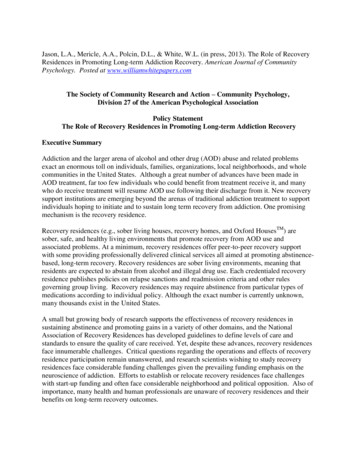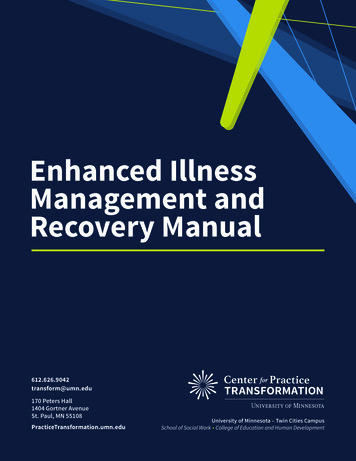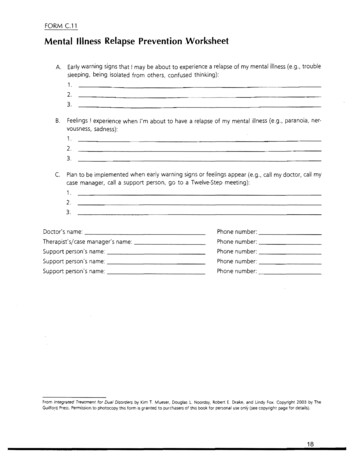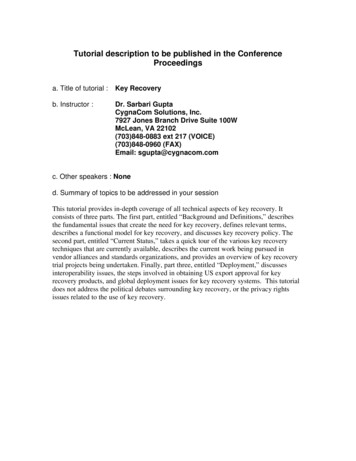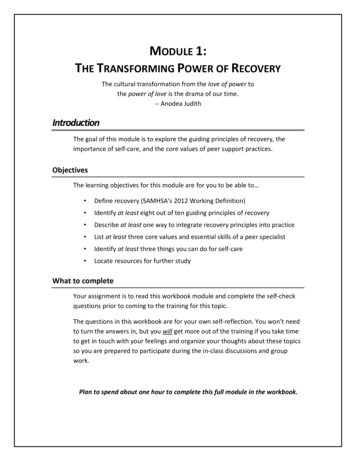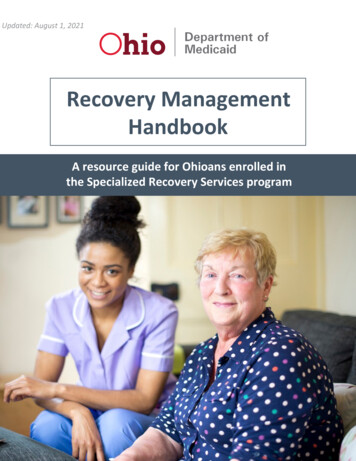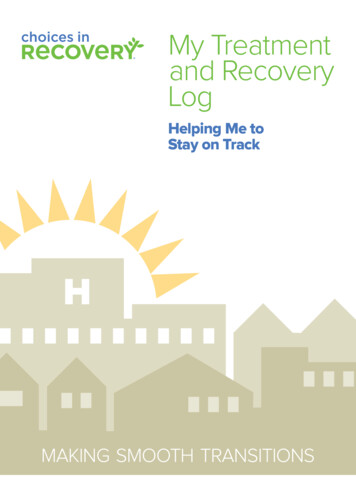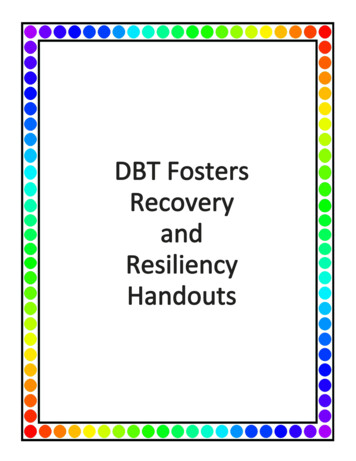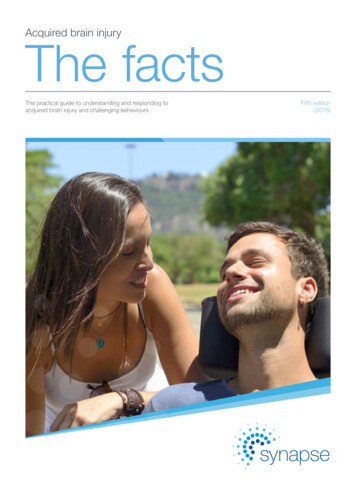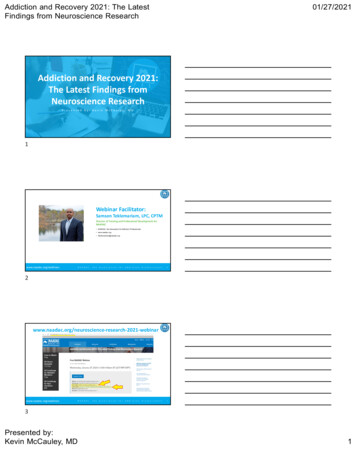
Transcription
Addiction and Recovery 2021: The LatestFindings from Neuroscience Research01/27/2021Addiction and Recovery 2021:The Latest Findings fromNeuroscience ResearchP re s e n te d b y : Ke v i n M c C a u l ey, M D1Webinar Facilitator:Samson Teklemariam, LPC, CPTMDirector of Training and Professional Development forNAADAC NAADAC, the Association for Addiction Professionals www.naadac.org Steklemariam@naadac.orgwww.naadac.org/webinarsN A A D A C ,t h eA s s o c i a t i o nf o rA d d i c t i o nP r o f e s s i o n a l webinarCost to Watch:FreeCE HoursAvailable:1.5 CEsCE Certificatefor NAADACMembers:FreeCE Certificatefor Nonmembers: 20www.naadac.org/webinarsN A A D A C ,t h eA s s o c i a t i o nf o rA d d i c t i o nP r o f e s s i o n a l s3Presented by:Kevin McCauley, MD1
Addiction and Recovery 2021: The LatestFindings from Neuroscience Research01/27/2021Using GoToWebinar(Live participants only) Control Panel Asking Questions Handouts Audio (phone option) Polling Questionswww.naadac.org/webinarsN A A D A C ,t h eA s s o c i a t i o nf o rA d d i c t i o nP r o f e s s i o n a l s4Webinar Presenter:Kevin McCauley, MDMeadows Behavioral Healthcare Senior Fellow Graduate of Drexel University College of Medicine Former U.S. Naval Flight Surgeon Writer and Director: Memo to Self: Protecting Sobriety with the Science ofSafety and Pleasure Unwoven: An Explanation of the Brain Disease of Addiction 2010 Michael Q. Ford Award for Journalism from the National Association ofAddiction Treatment Providerswww.naadac.org/webinarsN A A D A C ,t h eA s s o c i a t i o nf o rA d d i c t i o nP r o f e s s i o n a l s5The Neuroscience of Addictionand RecoveryKevin McCauley, MDSenior FellowThe Meadows of WickenburgNAADAC Webinar SeriesJanuary 20216Presented by:Kevin McCauley, MD2
Addiction and Recovery 2021: The LatestFindings from Neuroscience Research01/27/2021 Kevin McCauley declares no conflicts of interest,real or apparent, and no financial interests in anycompany, product, or service mentioned in thisprogram, including grants, employment, gifts, stockholdings, and honoraria. The interventions mentioned in this program are foreducational purposes and should not be interpretedas medical advice. While application of theseinterventions is discussed, other factors couldcontribute to the outcomes when applied in ease Model” lecture: things that have to get done relapse preventioncross-addictionunconscious nature of triggers“powerlessness” & “unmanageability” and the Frontal CortexAA as a social-spiritual method of stress managementimportance of trauma work (when appropriate)genetic determinism problemimportance of peer support for brain healing and maintenanceintroduction to recovery management concepts8“Disease Model” lecture: things that have to get done relapse preventionthe therapeutic “turn”“I can’t do this alone;cross-addictionI’m going to need someunconscious nature of triggershelp”“powerlessness” & “unmanageability” and the Frontal CortexAA as a social-spiritual method of stress managementimportance of trauma work (when appropriate)genetic determinism problemimportance of peer support for brain healing and maintenanceintroduction to recovery management concepts9Presented by:Kevin McCauley, MD3
Addiction and Recovery 2021: The LatestFindings from Neuroscience Research01/27/2021Pathways into AddictionGenetics / EpgeneticsADDICTION10OPIOID EXPOSURE: Pain Management Pathways intoAddictionGenetics / Epigenetics(ex.Deficiency(ex RewardTaq1A1allele)Syndrome)Depression / AnxietyOther Mental IllnessRewardDeficiencySyndromeEarly Use / PeerUse / Parental UseADDICTIONTrauma ibedMedicationChronic Pain11CO-OCCURRING DISORDERS: Self-Medication Pathwaysinto AddictionGenetics / Epigenetics(ex.Deficiency(ex RewardTaq1A1allele)Syndrome)Depression / AnxietyOther Mental IllnessRewardDeficiencySyndromeEarly Use / PeerUse / Parental UseADDICTIONTrauma ibedMedicationChronic Pain12Presented by:Kevin McCauley, MD4
Addiction and Recovery 2021: The LatestFindings from Neuroscience Research01/27/2021STRESS: Stress & Trauma Pathways into AddictionGenetics / Epigenetics(ex.Deficiency(ex RewardTaq1A1allele)Syndrome)Depression / AnxietyOther Mental IllnessRewardDeficiencySyndromeEarly Use / PeerUse / Parental UseADDICTIONTrauma ibedMedicationChronic Pain13ASAM Addiction Definition (2011)Addiction is a primary, chronic disease of brain reward,motivation, memory and related circuitry characterized by1. inability to consistently abstain2. impairment in behavioral control3. craving4. diminished recognition of significant problems withone’sbehaviors and interpersonalrelationships,and a5. dysfunctional emotional responseASAM Board of Directors. Definition of Addiction (Long Version). Chevy Chase, MD: American Society of Addiction Medicine; April 12, 2011.14ASAM Addiction Definition Updated (2019) Addiction is a treatable, chronic medical disease involvingcomplex interactions among brain circuits, genetics, theenvironment, and an individual’s life experiences. People with addiction use substances or engage in behaviorsthat become compulsive and often continue despite harmfulconsequences. Prevention efforts and treatment approaches for addiction aregenerally as successful as those for other chronic diseases.American Society of Addiction Medicine Definition of Addiction. (2019, September 15). -addiction.15Presented by:Kevin McCauley, MD5
Addiction and Recovery 2021: The LatestFindings from Neuroscience Research01/27/2021GENES - not the cause of addiction, but a powerfulmediatorgenetics / epigenetics1. Addiction is a disorder of PLEASURE - a hedonic dysfunction / broken ”pleasureDOPAMINE – reward expectancy(value / probability in the future)2. Addiction is a disorder of CHOICE - a volitional disorder(impaired decision making loss of insight)3. Addiction is caused by STRESSchronictrauma/PTSDsevererepetitived/opoorly managedearly in lifeinheritedACEsMDD/GAD/BipolarADHD16Frontal Cortex:PFC: Prefrontal Cortex- executive functioning- behavioral inhibitionACG: Anterior Cingulate Cortex- social cognition- error detectionOFC: Orbitofrontal Cortex- valuation under shiftingconditions of uncertaintyInsular Cortex - interoceptionMemory/Learning Areas:Hipp: Hippocampus- memory formationAmyg: Amygdala- fear conditioningVTAReward/Salience Areas:NAc: Nucleus accumbens(ventral striatum)VP: Ventral PallidumVTA: Ventral Tegmental Area(midbrain)17Frontal Cortex:PFC: Prefrontal Cortex- executive functioning- behavioral inhibitionACG: Anterior Cingulate Cortex- social cognition- error detectionOFC: Orbitofrontal Cortex- valuation under shiftingconditions of uncertaintyInsular Cortex - interoceptionMemory/Learning Areas:Hipp: Hippocampus- memory formationAmyg: Amygdala- fear conditioningVTAReward/Salience Areas:NAc: Nucleus accumbens(ventral striatum)VP: Ventral PallidumVTA: Ventral Tegmental Area(midbrain)18Presented by:Kevin McCauley, MD6
Addiction and Recovery 2021: The LatestFindings from Neuroscience Research01/27/2021Addiction is a disorder of 5. CHOICE (motivation, insight)IC4. STRESS(anti-reward system)3. MEMORY(habits, cues)remodeling2. REWARDOFC, ACC, PFC,HPA axisglutamatesynaptic(incentive salience)dopaminedopaminereceptors1. GENES (vulnerability)polymorphismsepigenetic19DSM-5 Criteria for “ Substance Use Disorder”( 2 or more in the last year )VALUATIONFAILURE TO FULFILL major work, school, & home obligations dueto drug useLARGER AMOUNTS of drug used over LONGER PERIODS thanintendedPHYSICAL & PSYCHOLOGICAL PROBLEMS due to drug does notcurtail useIMPORTANT ACTIVITIES are given up in favor of the drugLEARNINGCOGNITION/EMOTION /DECMAKINGINABILITY to cut down or control drug useA LOT OF TIME spent obtaining, using & recovering from drug useHAZARDOUS situations occur involving drug useSOCIAL & INTERPERSONAL PROBLEMS due to drug does notcurtail useAmerican Psychiatric Association. (2017). Diagnostic and statistical manual of mental disorders: DSM-5.CRAVING20DSM-5 Criteria for “ Substance Use Disorder”( 2 or more in the last year )VALUATIONLEARNINGCOGNITION/EMOTION /DECMAKINGFAILURE TO FULFILL major work, school, & home obligations dueto drug useLARGER AMOUNTS of drug used over LONGER PERIODS thanintendedPHYSICAL & PSYCHOLOGICAL PROBLEMS due to drug does notcurtail useIMPORTANT ACTIVITIES are given up in favor of the drugINABILITY to cut down or control drug useA LOT OF TIME spent obtaining, using & recovering from drug useHAZARDOUS situations occur involvinglack of drugempathyusenorcriminalitynot requiredSOCIAL & INTERPERSONAL PROBLEMSdueto drug does notcurtail useAmerican Psychiatric Association. (2017). Diagnostic and statistical manual of mental disorders: DSM-5.CRAVING21Presented by:Kevin McCauley, MD7
Addiction and Recovery 2021: The LatestFindings from Neuroscience Research01/27/2021Is addiction really a “disease?”22Common challenges to theConceptualizationof Addiction as a Disease There’s no evidence that addiction is a brain disease and there have been no advances in treatment based on brainresearch Most people mature out of their addictions Drug use is situational (Vietnam Vets & heroin study) Drugs don’t cause addiction (Rat Park study) We’re all addicted to something it doesn’t matter 23Ways to define “Disease” By “fiat” a disease is just that which we call it Normative a disease is something that isn’t considered“normal” Biostatistical a disease is a certain number of standarddeviations above/below the mean Pathophysiological a disease is a physical defect in anorgan or organ system that leads to observable,measurable signs and symptoms (this is the right one)24Presented by:Kevin McCauley, MD8
Addiction and Recovery 2021: The LatestFindings from Neuroscience Research01/27/2021The Four Fathers of the “Disease Model”Louie, Bobby, Rudy and IggyRobert Koch(1843 – 1910)Louis Pasteur(1822 – 1895)Ignaz Semmelweis(1818 – 1865)Rudolf Virchow(1821 – 1902)this guy ridiculed this guyfor his ideas about disease25ORGANDEFECTTHEDISEASEMODELDEFECT(a powerfulcausal model)SYMPTOMS & SIGNS26A “Disease”Broken LegDiabetes IORGANFemurPancreasDEFECTFracturebeta cell deathno insulinSYMPTOMS & SIGNSLeg PainLeg SwellingCan’t Walk1. Polyuria2. Poor healing3. Blurred VisionEtc.27Presented by:Kevin McCauley, MD9
Addiction and Recovery 2021: The LatestFindings from Neuroscience Research01/27/2021The Flexner Report (1910) Medical Schools should be research-oriented,laboratory facilities that adhere to the principles ofscience Lengthened and standardized medical educationoriented around biochemistry, physiology andmicrobiology (embraced ”Germ Theory” of disease) Called for fewer medical schools with higherstandards for admission Many medical schools reverted to male-onlyadmissions (except the Women’s Medical College ofPennsylvania) and all but two historically blackmedical schools (Meharry and Howard) were closedMedical Education in the United States and Canada: A Report to the Carnegie Foundation for the Advancement of Teaching. (2004). In C. Rose (Ed.), AmericanDecades Primary Sources (Vol. 2, pp. 143-147). Gale. /apps/doc/CX3490200259/BIC?u uarizona main&sid BIC&xid 96b3a0e28A ECTSYMPTOMS & SIGNS?Unable to “fit”addiction to their new,scientific model ofdisease, doctorsdecided that addictionwas NOT A DISEASEand that peoplewith addictionwere NOT PATIENTSBadness!result:Harrison Narcotic Actpassed in 1914making drug use (andtreatment of drugaddicts) a crime29addiction.surgeongeneral.govU.S. Department of Health and Human Services (HHS), Office of the Surgeon General, Facing Addiction in America: TheSurgeon General’s Report on Alcohol, Drugs, and Health. Washington, DC: HHS, November 2016.30Presented by:Kevin McCauley, MD10
Addiction and Recovery 2021: The LatestFindings from Neuroscience Research01/27/2021U.S. Department of Health and Human Services (HHS), Office of the Surgeon General, Facing Addiction in America: TheSurgeon General’s Report on Alcohol, Drugs, and Health. Washington, DC: HHS, November 2016.31A “Disease”Addiction (SUD)ORGAN1. Genetic/Epigenetic mech.s2. Striatum/Limbic Brain3. HPA Axis4. Frontal Cortex1. Polymorphisms2. DA/GLUsignaling3. CRF allostasis4. hypofrontalityDEFECTSYMPTOMS & SIGNS1. loss of control2. craving3. persistent usedespite neg. conseq.4. IDM LOIToday we can ”fit”addiction to theDisease Model withan importantconsequence: ifaddiction is adisease then peoplewith addiction arepatients and havethe same right toethical care as allother patients32one unfortunate consequence of the causal power of the “Disease Model” .We’re good atAcute DiseaseREDUCTIVE: simple causation (traumatic, infectious,toxicologic)EMERGENT: rapid onset, severe symptoms, shortdurationEPISODIC CARE: Usually cured with a single,intense, time-limited hospitalization involving definitivetreatment with MATERIALISTIC: primarily surgical orpharmacological interventionsTECHONOCRATIC: Expert delivered, expensive,encourages “sick role” dependency, poorly targeted,fragmented careEx. Heart Attack, Pneumonia, Encephalitis, traumaticinjuryNow we need to get better atChronic DiseaseCONTEXTUAL: multiple causation (geneticvulnerability, early adverse experiences, poverty, societaldisenfranchisementVARIABLE COURSE: sudden or gradual onset,relapsing, life-course variationsLONGITUDINAL CARE: non-urgent, across the lifespan, electronic health records, preventive focusPATIENT-CENTERED: care takes personal values,cultural context and spiritual considerations into accountCOMMUNITY-BASED: mix of professional and laytreatment, team approach, continuous relationshipsEx. Heart Disease, Diabetes, Asthma, Addiction,Depression, etc.33Presented by:Kevin McCauley, MD11
Addiction and Recovery 2021: The LatestFindings from Neuroscience Research01/27/2021From the “Disease Model” of Addiction to a “Public Health/Ecological Model” ofRecoveryThe Public Health Model of Recoverylife coursesocietal contexteducational opportunityidentityhousingall the causalThe Disease Modelpower of theof AddictionDisease Model iscontained withinmental healththe Public HealthmedicationModel it is notprimary carepossible to simultaneouslydetox & treatmentmake the argument thataddiction is not a diseaseand advocate for a PublicHealth approach to addictiondisparityfamilysocial supportoccupationcultural contextfaith, meaning and purposepoliticalcontext34Discrepant findingsfor which the Disease Model must account . Lee Robins (Vietnam Vets)1: drug use is situational Bruce Alexander (Rat Park)2: it’s not the drug that causesaddiction, it’s the environment Marc Lewis3: addiction is a learned habit that can beunlearned; a developmental disorder not a disease Gene Heyman4: most people with addiction do NOT progressor die – most stop when they get older and start makingbetter choices1. Robins, L. N. (1993). Vietnam veterans rapid recovery from heroin addiction: a fluke or normal expectation? Addiction, 88(8), 1041–1054. doi: 10.1111/j.1360-0443.1993.tb02123.x2. Alexander, B. K., Coambs, R. B., & Hadaway, P. F. (1978). The effect of housing and gender on morphine self-administration in rats. Psychopharmacology, 58(2), 175–179. doi: 10.1007/bf004269033. Lewis, M. D. (2018). The biology of desire: why addiction is not a disease. Vancouver, B.C.: Langara College.4. Heyman, G. M. (2010). Addiction: a disorder of choice. Cambridge, MA: Harvard University Press.3535Vietnam Vets Study (Robins, 1975) High prevalence of heroin use in USsoldiers in Vietnam On returning to the US, they did notcontinue heroin use Drug use was situational Often used as argument againstaddiction being a disease, butauthors stated later that whatsurprised them was the idea that anyheroin addicts recovered Counter-argument: Stress theories ofaddiction can explain changingvulnerabilityShutterstock.comRobins L. N. (1993). The sixth Thomas James Okey Memorial Lecture. Vietnam veterans' rapid recovery from heroin addiction: a fluke or normal expectation?.Addiction (Abingdon, England), 88(8), 1041–1054. 36Presented by:Kevin McCauley, MD12
Addiction and Recovery 2021: The LatestFindings from Neuroscience Research01/27/2021Bruce Alexander PhD: “Rat Park”Study Morphine consumption by rats housed in isolation vssocially Isolated rats drank more morphine (n 32 rats) Both groups drank plenty of morphine, and 5 rats diedof morphine overdoses (2 in the isolated group and 3in the socially-housed group) Implication: morphine is more reinforcing in isolatedenvironments and less so in enriched environments Study has some problems, and subsequent replicationstudies had mixed results Point taken: Housing matters But: how do you know “cross-addiction” didn’t occur?Alexander BK, Coambs RB, Hadaway PF. The effect of housing and gender of morphine self-administration in rats.Psychopharmacology (1978) 58: 175-179.37Marc Lewis, PhD: The Biology of Desire Brain changes do not necessarily indicatepathologyPlasticity and synaptic pruning (learning) arenormal functions of the brain Addiction is a deep form of learning, suboptimalbut non-pathologic Motivated repetition remodels the brain causingintense desire for drugs (craving)strong cues to repeatover-valuation of drugnarrowing of focus The very thing that got a person into addiction(plasticity) can get them out (development pastaddiction into recovery)Counter-argument:Kalivas’ work on pathologicLewis, M. D. (2018). The biology of desire: why addiction is not a disease. Vancouver,B.C.: Langara College.memory 38Gene Heyman, PhD: Addiction: A Disorder ofChoice Self-destructive behaviors such as addiction can be chosenbehaviorGenes affect voluntary behavior (just because a behavior has agenetic cause doesn’t make it involuntary)Brain changes from drug use do not make it involuntaryMost addicts do stop on their own, without treatment, and do notdisplay relapse chronicityRemission (“maturing out”) is the rule, not the exceptionAddicts do not need lifelong treatmentRemission rates lower for legal drugs than illegal drugsCounter-argument: Punishments are unreliable predictors ofcontinued use, and behaviorism alone cannot explain thephenomenological experience of addictionAlso: see William White response to Heyman – communitybased studies often differ from clinical experienceHeyman, G. M. (2010). Addiction: a disorder of choice. Cambridge, MA: Harvard University Press.39Presented by:Kevin McCauley, MD13
Addiction and Recovery 2021: The LatestFindings from Neuroscience ResearchLopez-Quintero C, et al. Probability and predictors of remission from lifetime nicotine, alcohol, cannabis, or cocainedependence: results from the National Epidemiologic Survey on Alcohol and Related Conditions (NESARC).Addiction. 2001(March); 106(3): 657-669.01/27/20214040A “Disease” of Volition Could such a thing exist? (I’m making an ontologic argument that it can) What would happen if such a thing existed? (most advocates for addictionbeing a disease who run treatment centers are making this teleologicargument) What is the nature of volition/free will/choice? Is there something special (non-material) about “choice?” If so, what is it? If not, then how is “choice” realized in the brain, and how is addictionfundamentally different from any other brain disease process? It is very hard for Americans especially to accept addiction as a diseasebecause we print words like “Liberty” on our money41What would it be like if there could be a such thing as a “broken leg?”Broken Leg Hurts Deformity / Trauma Disability Want to get up and run (can’t) Confusion when can’t Tx: fixation / immobilization Healing / Physical therapy /- Lifelong vulnerability42Presented by:Kevin McCauley, MD14
Addiction and Recovery 2021: The LatestFindings from Neuroscience Research01/27/2021What would it be like if there could be a such thing as a “volitionaldisorder?”VolitionBroken Leg Hurts Emotional/Spiritual pain Deformity / Trauma Unmanageability Disability Phys/Psych/Soc/Occup Want to get up and run (can’t) Consequences “Countless attempts” to make it Confusion when can’twork Tx: fixation / immobilization “Bafflement” when it doesn’t Healing / Physical therapy Tx: “Turning over one’s will & life” /- Lifelong vulnerability Graduated exercises of volition Volitional segregation (Serenity43Two Areas of Brain Research that reinforce the ideathat volition can be part of a disease process1.2.44Two Areas of Brain Research that reinforce the ideathat volition can be part of a disease process1. EpigeneticsEnvironmentally,behaviorally, and sociallycaused DNA modifications,reversible but possiblyheritable, that do not changeDNA sequence but that canaffect gene expression.2.45Presented by:Kevin McCauley, MD15
Addiction and Recovery 2021: The LatestFindings from Neuroscience Research01/27/2021How does Addiction (SUD)run in families?What is the genetic componentof Addiction (SUD)?46Addiction is a disorder of 5. CHOICE (motivation, insight)IC4. STRESS(anti-reward system)3. MEMORY(habits, cues)remodeling2. REWARDOFC, ACC, PFC,HPA axisglutamatesynaptic(incentive salience)dopaminedopaminereceptors1. GENES ty of Addiction(from twin studies) Heritability: an aggregatemeasure of the variability of acharacteristic due to geneticsvs environment (the risk dueto genes – “risk genes”) First-order family members ofa person with SUD have a 4– 8 x increased risk ofdeveloping SUD Applies to populations, notshifts from adolescenceindividuals (that would be(environment)inheritance )to young adulthood (genetics) Probabalistic, notdeterministicAgrawal, A.,Gambling:Verweij, K. J., Gillespie, N. A., et al. (2012).The genetics of addiction-a translational perspective. Translational psychiatry, 2(7), e140. https://doi.org/10.1038/tp.2012.5449%Alcohol: 48 – 66%Cannabis:51 –59%Cocaine: 42 – 79%Opioids: 23 – 49%Nicotine: 33 – 71%48Presented by:Kevin McCauley, MD16
Addiction and Recovery 2021: The LatestFindings from Neuroscience Research01/27/2021Heritability of Addiction(from twin studies) Heritability: an aggregatemeasure of the variability of acharacteristic due to geneticsvs environment (the risk dueto genes – “risk genes”) First-order family members ofa person with SUD have a 4– 8 x increased risk ofdeveloping SUD Applies to populations, notshifts from adolescenceindividuals (that would be(environment)inheritance )to young adulthood (genetics) Probabalistic, notdeterministicAgrawal, A.,Gambling:Verweij, K. J., Gillespie, N. A., et al. (2012).The genetics of addiction-a translational perspective. Translational psychiatry, 2(7), e140. https://doi.org/10.1038/tp.2012.5449%Alcohol: 48 – 66%Cannabis:51 –59%Cocaine: 42 – 79%Opioids: 23 – 49%Nicotine: 33 – 71%49Taq1 A1 allele of the DRD2 gene(Blum & Noble, 1990)A single nucleotide polymorphismthe carriers of which have 30-40%fewer DAD2 receptors and are athigh risk for: Alcoholism and Addiction Repeated addiction treatmentfailures Increased mortality fromalcoholism Lower striatal DAD2 receptoravailability and lower striatal DAbinding potentialChromosome 11Blum K, Noble EP, Sheridan PJ, et al. Allelic association of human dopamine D2 receptor gene in alcoholism. JAMA. 1990; 263(15):2055-60.50Epigenetics Overkalix study: Starvationduring adolescence increasedthe prevalence of diabetes ingrandchildren Holocaust survivors withPTSD: their children also hadPTSD without having beenexposed to trauma A mechanism exists totransmit environmentalexposure information fromone generation to the next tothe next51Presented by:Kevin McCauley, MD17
Addiction and Recovery 2021: The LatestFindings from Neuroscience ResearchOverkalix ityDecreased DM Grandsonthe stressors faced byone generation can havetransgenerational influenceon disease expression(ex. Trauma is heritable)IncreasedGranddaughterDM52National Institutes of Health - 3Nicotine primes cocaine use(Kandel & Kandel) Nicotine acts as a “Gateway Drug” forcocaine Nicotine for 7 days enhanced rewardingproperties of cocaine Effect is unidirectional: did not see cocaineprime nicotine Nicotine inhibits histone deacetylasecausing widespread acetylation in thestriatumShutterstock.comDr.s Eric & Denise KandelKandel, E. R., & Kandel, D. B. (2014). Shattuck Lecture. A molecular basis for nicotine as a gateway drug.The New England journal of medicine, 371(10), 932–943. https://doi.org/10.1056/NEJMsa140509254Presented by:Kevin McCauley, MD18
Addiction and Recovery 2021: The LatestFindings from Neuroscience Research01/27/2021GENES: Genetic / Epigenetic Pathways into AddictionGenetics / Epigenetics(ex.Deficiency(ex meDepression / AnxietyOther Mental IllnessEarly Use / PeerUse / Parental UseADDICTIONTrauma ibedMedicationChronic Pain55How does what we know about genetics help me getsober? Genes are a powerful influence on our behavior (voluntary andinvoluntary) and our choices Epigenetics, too, deepens our understanding of how we makechoices But genetics and epigenetics do not determine our behaviors andchoices We can “acquire” resiliency in recovery to offset our geneticvulnerability Epigenetics provides a mechanism by which recovery can beheritable too56Two Areas of Brain Research that reinforce the ideathat volition can be part of a disease process1. Epigenetics2. PsychoneuroimmunologyThe interaction between thephysical and psychologicalfunctioning of the CNS andthe immune system (ex. theimmune system is thebrain’s sensory organ forstress).57Presented by:Kevin McCauley, MD19
Addiction and Recovery 2021: The LatestFindings from Neuroscience Research01/27/2021Two Areas of Brain Research that reinforce the ideathat volition can be part of a disease process1. Epigenetics2. PsychoneuroimmunologyThe interaction between thephysical and psychologicalfunctioning of the CNS andthe immune system (ex. theimmune system is thebrain’s sensory organ forstress).58Psycho-neuro-immunology A way to understand how stress and trauma cause mental illness through theimmune system (the immune system is the stress Adler & Cohen (1975): conditioned rats to drink saccharin water & Cytoxan(an immunosuppressant drug that tastes bad); later when they dranksaccharin water the rats died of infection (immunosuppression in the absenceof Cytoxan) Visintainer (1983): inescapable tail shock associated with decreasedlymphocyte proliferation and decreased tumor rejection Also: lower antibody response to psychotic individuals given pertussisvaccination The Immune-Brain(-Gut) Loop: immune system is in constant communicationwith the brain (and the digestive system) CNS neurons terminate in thymus and spleen near clusters of lymphocytesdh59Inflammation(“-itis”) a physiologic (normal) response of the body to pathogens(infection), irritants (intoxication) or tissue damage (injury) ( that toomuch of kills u) protective response: immune cells, blood vessels, & chemicalmediators also to repair tissue damage & clear out necrotic cells acute inflammation: movement of white blood cells into the areamaturation of those white blood cellsamplification of their response chronic inflammation:simultaneous destruction and healing oftissueshift of the type of cells in the area60Presented by:Kevin McCauley, MD20
Addiction and Recovery 2021: The LatestFindings from Neuroscience Research01/27/2021Microglia Predominant immune cells ofthe CNS Cover a specific territory Usually in resting (ramified)state Secrete Brain-DerivedNeurotrophic Factor (BDNF) Assist neuronal circuitremodeling acrossdevelopment (synapticpruning) Responsible for CNS61Reactive Microgliosis: response to pathogen/injury Resting microglia: injury to brain Reactive Microgliosis Microglia respond rapidly to stress andtrauma Shift from ramified (resting) state toameoboid (activated) state Microglia are very fast moving cells(fastest in the brain: entire brainparenchyma scanned by microglia everyfew hours) Become macrophages phagocytizepathogens and debris Antigen-presenting cell to T lymphocytes62Genetics / EpigeneticsGenetics / Epgenetics(ex Taq1A1 allele)Depression / AnxietyOther Mental IllnessRewardDeficiencySyndromeAll of these pathwayspass through andare affected by Early Use / PeerUse / Parental UseTrauma cesChronic PainPrescribedMedicationCortical Dysfunction63Presented by:Kevin McCauley, MD21
Addiction and Recovery 2021: The LatestFindings from Neuroscience Research01/27/2021Genetics / EpigeneticsGenetics / Epgenetics(ex Taq1A1 allele)Depression / AnxietyOther Mental IllnessRewardDeficiencySyndromeInflammationEarly Use / PeerUse / Parental UseADDICTIONTrauma c PainPrescribedMedicationCortical Dysfunction641. Addiction is a disorder of PLEASURE2. Addiction is a disorder of CHOICESymptoms of Addiction (S.U.D.):3. Addiction is caused by STRESS1. Loss of Control2. Persistent Drug Use Despite NegativeConsequences3. Relapse4. Craving5. Impaired Decision-making Loss of Insight65What causes thePersistent Use Despite Negative Consequencessymptom of Addiction (SUD)?66Presented by:Kevin McCauley, MD22
Addiction and Recovery 2021: The LatestFindings from Neuroscience Research01/27/2021Addiction is a disorder of 5. CHOICE (motivation, insight)IC4. STRESS(anti-reward sys
Jan 27, 2021 · introduction to recovery management concepts “Disease Model” lecture: things that have to get done relapse prevention cross-addiction unconscious nature of triggers “powerlessness” & “unmanageability” and the Frontal Cortex AA as a social-spiritual method of stress managem


